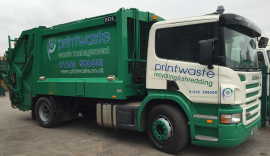
How does waste produce energy?
The Printwaste ‘Waste-to-Energy’ service does exactly what it says on the tin, it converts regular general waste into electricity and heat. But how? This article aims to provide you with all the need to knows.
Why ‘Waste-to-Energy’?
Using a ‘Waste-to-Energy’ scheme you’re reducing the waste that ends up as landfill and increasing the energy security of electricity and heat through waste recovery.
Think about this; your bins are no longer full of waste, they’re actually full of recoverable and reusable energy to help power workplace and household appliances such as computers and dishwashers. But how exactly does this happen?
What’s the process?
Below we’ve split the process into six core elements:
Collection – on a pre-arranged day to suit you, a Printwaste operator will collect the general waste material from your premises and transport it to our facility in Cheltenham, before being taken to a reprocessing plant where it’s prepared for waste recovery.
Preparation – the waste is prepared for recovery with the use of industrial sprinklers and induction fans. These are used to remove excess dust and reduce smells.
Furnace – waste is then loaded by crane into a feed hopper, before travelling down the feed chute and into the furnace.
Incineration – when entering the furnace, the waste goes through a process called ‘incineration’. Incineration involves drying out the waste and burning it at scorching hot temperatures of around 1000°C. This results in the creation of two different materials: hot flue gas and IBA (Incineration Bottom Ash).
Gas to Electricity – post incineration, the hot flue gases travel through a boiler, transferring heat into water which runs through the boiler pipes. Steam is then created by the hot water which drives the wind turbines which generate electricity – and there’s our renewable source of energy!
Burnt waste causes excess gases. These are thoroughly cleaned through a two-part cleaning system; 1) lime is added to neutralise acid gases 2) carbon is added to remove dioxins and heavy metal. The gas then passes through a fine fabric filter to capture any remaining particles before being released through a chimney.
IBA – made up of mixed ceramics and metals, IBA is the by-product of incinerated waste. The large elements (bricks, stones and metals) are screened out and re-used or recycled, the remaining ash is classified by either non-hazardous or hazardous waste. Non-hazardous waste can be used as the sub layer of road pavements, whereas hazardous waste requires further treatment.
If you’d like to know more about the waste-to-energy service we offer, feel free to contact us here.

